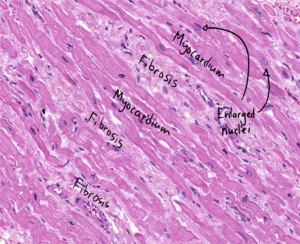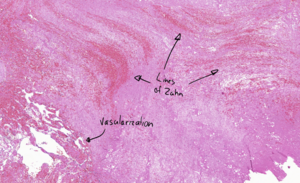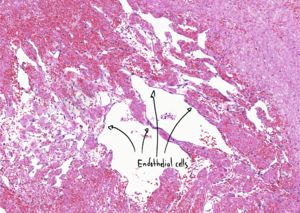19. Thrombus and postmortem blood clot
Staining: HE

Organ: Thrombus (with myocardium) and postmortal clot
Description:
Two different pieces of tissue are on the slide, one to the left and one to the right. The tissue to the right has no structure. It contains RBCs, WBCs and fibrin in a random arrangement. The tissue to the left has structure. On the bottom there is myocardium with interstitial fibrosis and enlarged nuclei. On the top we can see a lot of eosinophilic acellular material, some cells and RBCs. Some endothelial cells can also be seen.
Causes of thrombosis:
- Virchow’s triad
- Endothelial damage
- Abnormal blood flow
- Hypercoagulability

Theory:
The tissue to the right is a postmortal clot. It has no structure; it’s just the remnants of cells and fibrin that clump together after death.
The tissue to the left is a thrombus attached to some myocardium. The myocardial cells have enlarged nuclei and we can see interstitial fibrosis among the myocardial cells, pointing to that this is hypertrophic myocardium.
The thrombus itself is of most interest here. It shows signs of organization, the process where thrombi, exudate or dead tissue is converted into fibrous tissue. These signs are most visible in the middle of the thrombus, marked as “Lines of Zahn” on the overview picture below.

If a thrombus doesn’t dissolve in around 24 hours will it undergo organization. Organization has three phases. In the first phase will macrophages and neutrophils digest the thrombus. In the second phase will fibroblasts enter the thrombus and initiate fibrosis. In the third phase will new vessels be formed inside the thrombus.
The lines of Zahn are alternating lines of fibrin and RBCs that can be seen both microscopically and macroscopically. These lines are one morphological sign of organization here.
The other sign of organization is the vascularization. Not far from the lines of Zahn can we see endothelial cells that are working to create new vessels.

